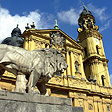LUTHERSTIEG – ST ANNE’S CHURCH AUGSBURG
The Luther Steps Museum
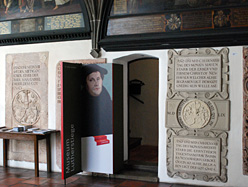 The Church of St Anne (St Anna in German) in Augsburg was once a Carmelite monastery, but gained its place in the story of the protestant reformation when Martin Luther, the monk who poked his stick in the eye of the Catholic Church when he nailed 95 Theses of objections to the practices of indulgences to the doors of the All Saints Castle Church in Wittenberg on October 31, 1517 (see Wittenburg Luther City), was called to Augsburg a year later in 1518.
The Church of St Anne (St Anna in German) in Augsburg was once a Carmelite monastery, but gained its place in the story of the protestant reformation when Martin Luther, the monk who poked his stick in the eye of the Catholic Church when he nailed 95 Theses of objections to the practices of indulgences to the doors of the All Saints Castle Church in Wittenberg on October 31, 1517 (see Wittenburg Luther City), was called to Augsburg a year later in 1518.
When Luther was summoned to the Imperial Diet at Augsburg in October of 1518 to be challenged in his heresies by Cardinal Cajetan, he resided in a small warren of rooms above the church choir at the monastery while he stayed in Augsburg. A museum in the St Anna church is dedicated to the Luther story up the steps which he climbed to his rooms, now known as the LutherSteig or Luther Steps.
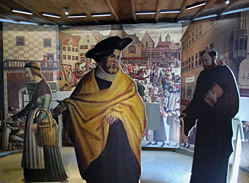 Cardinal Tommaso de Vio Cajetan, the Italian philosopher from Naples who had joined the Dominican Order, also known by his Latin name as Gaetanus, was the Roman Church’s chief theologian. Cajetan had just been raised to Cardinal and Archbishop of Palermo by Pope Leo X in 1517 after serving as the Dominican Master of the Order of the Preachers since 1508. He was the loudest opponent of Martin Luther’s criticisms and was sent to Augsburg as Papal Legate to interrogate and challenge the threat to Rome posed by an upstart monk.
Cardinal Tommaso de Vio Cajetan, the Italian philosopher from Naples who had joined the Dominican Order, also known by his Latin name as Gaetanus, was the Roman Church’s chief theologian. Cajetan had just been raised to Cardinal and Archbishop of Palermo by Pope Leo X in 1517 after serving as the Dominican Master of the Order of the Preachers since 1508. He was the loudest opponent of Martin Luther’s criticisms and was sent to Augsburg as Papal Legate to interrogate and challenge the threat to Rome posed by an upstart monk.
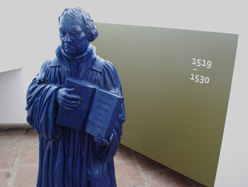 Martin Luther stayed in Augsburg from the 7th to the 20th of October 1518, almost a year since his actions at Wittenberg. For three days he was called to the palace of Jacob Fugger, host to the diet and sometimes called “the banker of Europe” (see Fugger-Welser Museum) to be confronted by Cajetan. Luther was not sure whether he might leave Augsburg alive again, telling his supporters, "Greet all in my name, whether I return or not."
Martin Luther stayed in Augsburg from the 7th to the 20th of October 1518, almost a year since his actions at Wittenberg. For three days he was called to the palace of Jacob Fugger, host to the diet and sometimes called “the banker of Europe” (see Fugger-Welser Museum) to be confronted by Cajetan. Luther was not sure whether he might leave Augsburg alive again, telling his supporters, "Greet all in my name, whether I return or not."
Facing Cajetan in three days of theological debate, the two most important questions of the arguments were whether it was the Pope who was the supreme authority of the Church, or Holy Scripture itself, and whether salvation could be obtained by good works, or through “faith alone”. Luther, of course believed he had the authority of his interpretation of scripture for his ideas, quoting Paul, “We regard man to become righteous without the law, but by faith alone."
Finally frustrated with the debate, Cajetan famously demanded. “This is my heartfelt advice to you: only if you say”Here is my heartfelt advice to you, if only you will say “I recant!” will you save yourself. Revoco! Six letters! You can utter them easily. Failing that, imagine what it means to make an enemy of the Church!”
But Luther did not recant. Knowing exactly what it meant to be an enemy of the church, he fled Augsburg back to Wittenberg, where he would be under the protection of the sympathetic Duke John of Saxony and shortly later, Cajetan would write the Bill of Excommunication that would threaten Luther as he built his faith doctrines and wrote his own translation of the Bible (see Luther at Wartburg Castle).
The Lutherstieg Museum
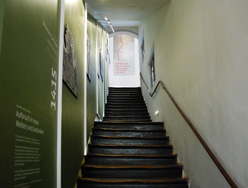 The Luther Steps exhibit museum is spread through six rooms, with 16 stations, entered by climbing the flight of creaking wooden stairs which Luther probably climbed to the rooms while he stayed while in Augsburg. There is not a certainty that Luther’s foot stepped here, as documenting the historical importance of Luther’s visit wouldn’t become apparent until much later, but as close as we’ll get. According to a letter Luther wrote later, he had a friendship with the Prior of St Anne, Johann Frosch, who hosted him when he stayed with the Carmelite monks at the monastery.
The Luther Steps exhibit museum is spread through six rooms, with 16 stations, entered by climbing the flight of creaking wooden stairs which Luther probably climbed to the rooms while he stayed while in Augsburg. There is not a certainty that Luther’s foot stepped here, as documenting the historical importance of Luther’s visit wouldn’t become apparent until much later, but as close as we’ll get. According to a letter Luther wrote later, he had a friendship with the Prior of St Anne, Johann Frosch, who hosted him when he stayed with the Carmelite monks at the monastery.
The museum consists of interactive exhibits and representational art, at the top of the stairs is a map showing the route Luther took from Wittenberg. In one room, you can listen (in German) to an audio representation of the theological debate between Luther and Cajetan. Pull out drawers offer detailed information of the themes. Some of the space is above the nave and choir of the beautifully Baroque church, where you might hear a choral practice while exploring the steps of the Reformation.
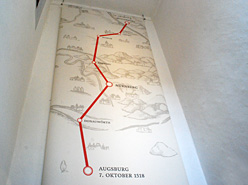 Themes cover the route of Luther to Augsburg, the division between Luther and the Catholic Church, the dispute with Cajetan, Luther’s faith, the media revolution which brought Luther’s ideas to the masses and Augsburg as a printing city, the iconography of Lutheran Images, both reverential and some of the anti-Lutheran propaganda art that might fit any modern twitter feed rant, the Augsburg Confession of June of 1530, and other Reformers, from contemporaries of Luther like Zwingli (see Reformation Museum Geneva), up to modern times.
Themes cover the route of Luther to Augsburg, the division between Luther and the Catholic Church, the dispute with Cajetan, Luther’s faith, the media revolution which brought Luther’s ideas to the masses and Augsburg as a printing city, the iconography of Lutheran Images, both reverential and some of the anti-Lutheran propaganda art that might fit any modern twitter feed rant, the Augsburg Confession of June of 1530, and other Reformers, from contemporaries of Luther like Zwingli (see Reformation Museum Geneva), up to modern times.
St Anne’s Church
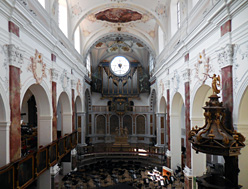 The St Anne Monastery was first built in 1321. Originally Catholic of course, the church converted to Lutheran in 1545. The ceiling of the main church was elegantly transformed to Baroque and Rococo in a restoration of 1747 to 1749 with paintings by Augsburg artist Johan Georg Bergmüller.
The St Anne Monastery was first built in 1321. Originally Catholic of course, the church converted to Lutheran in 1545. The ceiling of the main church was elegantly transformed to Baroque and Rococo in a restoration of 1747 to 1749 with paintings by Augsburg artist Johan Georg Bergmüller.
Gold Smith's Chapel
The Goldsmith's Chapel (Goldschmiedkapelle) was built thanks to a donation of gratitude from a wealthy couple, Konrad and Afra Hirn (Hyrn) in 1420, and after their death maintained as a burial chapel for the Augsburger Goldsmiths Guild, on the north side opposite the eastern choir, it was enlarged in 1485. There are original windows and walls are painted with frescoes of scenes from the Passion of Christ, from the Last Judgment, the battle of St. George and his dragon, and the procession of the Three Magi.
Fugger Chapel
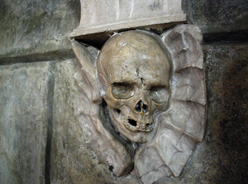 The Fugger Chapel was added in an expansion of the monastery church in 1509, by Jacob Fugger and his brother Ulrich who were patrons of the monastery, among their good works. Jacob Fugger is buried here, and the chapel architecture is the earliest example of the Renaissance in Germany. with partially remaining Renaissance frescos in the arches and Renaissance religious iconography (death skulls) in the stonework.
The Fugger Chapel was added in an expansion of the monastery church in 1509, by Jacob Fugger and his brother Ulrich who were patrons of the monastery, among their good works. Jacob Fugger is buried here, and the chapel architecture is the earliest example of the Renaissance in Germany. with partially remaining Renaissance frescos in the arches and Renaissance religious iconography (death skulls) in the stonework.
Visiting the Lutherstieg at St Anne’s Church
The open hours for the museum are 10 am to 6 pm Tuesday to Saturday (1 May to 31 October) 10 am to 5 pm (1 November to 30 April) and 12 noon to 5 pm Monday. Sunday and Holidays from 3 pm to 5 pm (1 May to 31 October) and 3 pm to 4 pm (1 November to 30 April). The museum is closed during church services. Admission is free. The church is tucked away though an arch alley off AnnaStrasse in the marketplace pedestrian zone. © Bargain Travel Europe
Best vacation deals compare prices in Bavaria at TripAdvisor
Web
Info:
St Anna Lutherstieg
These articles are copyrighted and the sole property of Bargain Travel Europe and WLPV, LLC. and may not be copied or reprinted without permission.
See Also:
MOZARTHAUS - LEOPOLD MOZART AUGSBURG
TREASURY ST PETER AND ALEXANDER - ASCHAFFENBURG

